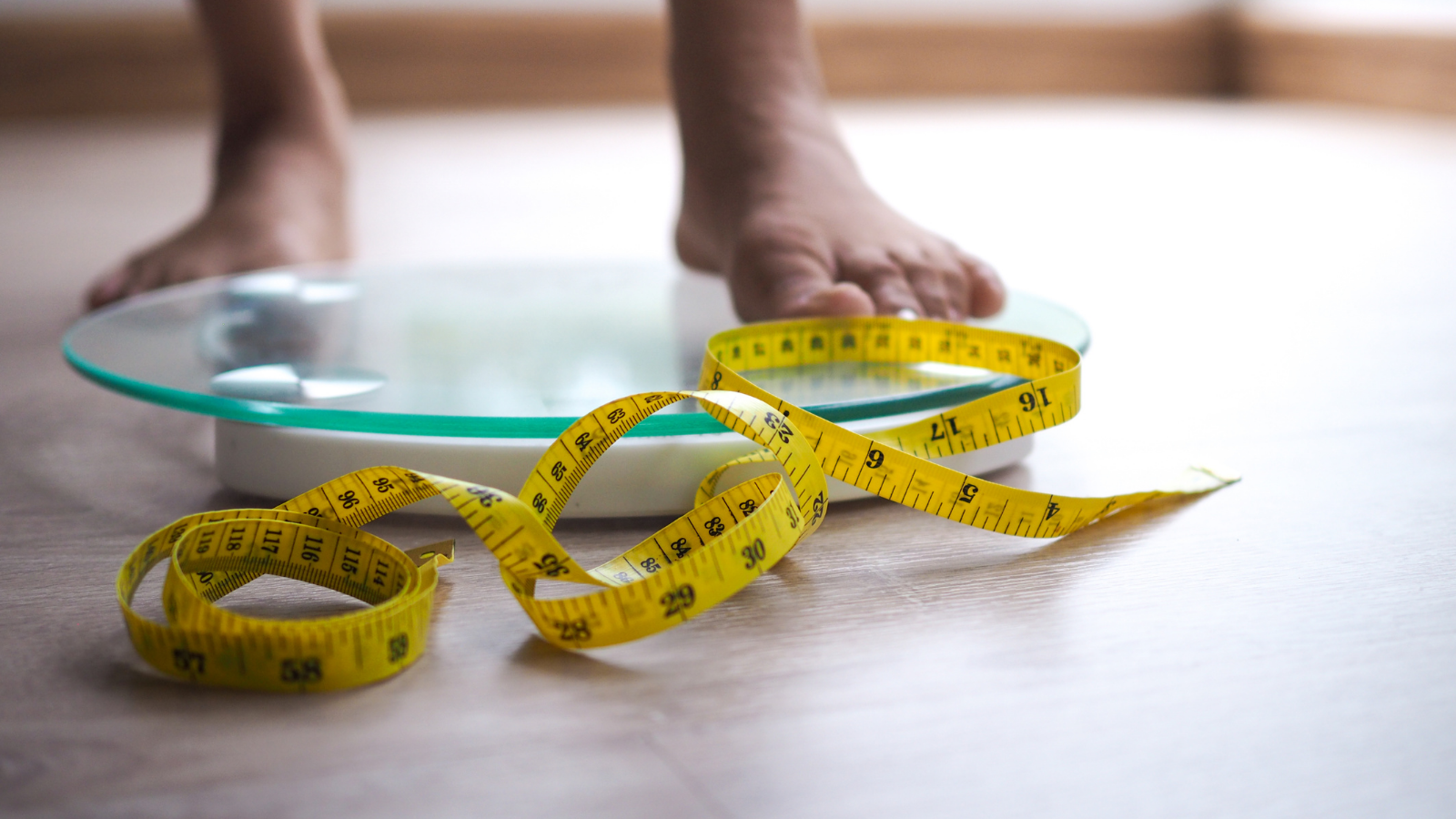
If you’ve been trying to change your weight or your body composition, you already know that progress isn’t linear. Maybe you’ve been tracking your weight and see no progress. If you’ve been eating a healthy diet and exercising on a routine basis, it can be so frustrating to feel like you’re not progressing toward a goal you set.
Why do these kinds of plateaus happen? And how can you push past them? In this article, we’ll cover the reasons why your weight or body composition might be remaining stable despite your efforts.
How you should think about weight loss

First, remember that your weight is not the full picture of your health. Think in terms of fat loss, not weight loss. For example, you might be gaining weight because you are building muscle —and that’s good news for your health!
Second, recognize that weight loss plateaus are normal. They’re definitely not a reason for guilt or despair. In the Journal of the Academy of Nutrition and Dietetics, researchers identified plateaus occurring across the board at the 6-month mark of a diet—with regimens ranging from “diet alone, diet and exercise, exercise alone, meal replacements, very-low-energy diets, weight-loss medications, and advice alone.”
Now that we cleared that up, you might be wondering if a plateau is your body’s way of telling you that this is the weight it wants to be at. What you are referring to is the “Set Point” theory and we will go into more detail in this next section.
What About Set Point?

Maybe, you’ve noticed that there’s a certain weight you feel the best at—a number range where you’ve felt happy, energetic, and mentally sharp. Or you feel like no matter what you do, you can’t make it past a certain weight.
Set point theory is the idea that your body weight is regulated at a predetermined or “preferred” range. While there are conflicting opinions on whether “set points” do exist, the bulk of research seems to suggest that set point theory is legit. This means your body will always “settle” within a certain range.
What does this theory mean for your health and body composition goals? Is it possible to change your body at all?
To answer this question, it’s important to understand how your body weight is determined and how that plays a role in your set point range.
Your body weight is determined by three things:
- Genes
- Environment (diet and exercise)
- Epigenetic effects (hormones)
In other words, a variety of factors like genes, hormones, exercise frequency, nutrition, and other physiological mechanisms help determine your body’s weight range.
Let’s look at each one of these in more detail.
The 3 factors that can determine a person’s body weight:
- Genes
- Environment (diet and exercise)
- Epigenetic effects (hormones)
In other words, a variety of factors like genes, hormones, exercise frequency, nutrition, and other physiological mechanisms help determine your body’s weight range.
Let’s look at each one of these in more detail.
1) The role of genetics on body weight set points
“It’s all genetics.” I’m sure you can think of at least one friend or family member who has used this as an excuse not to take care of their health.
Here’s the thing though: genetics play a role in how your body weight is determined … but they’re not your destiny.
Yes, there are genetic factors that can predispose people to a certain body weight set point range. However, researchers have found that “bad genes” are unlikely to explain the rapid rise of obesity rates around the globe. According to a review of several studies that looked at the link between genetics and obesity, “Moving from genetic predisposition to obesity itself generally requires some change in diet, lifestyle, or other environmental factors.”
The bottom line is this: high-calorie intake from an unhealthy diet and not genetics is usually the explanation for your body type. You can counteract your genetically predisposed body weight ranges through lifestyle changes – controlling your calorie intake, choosing nutrient-rich foods, and exercising.
2) The role of environmental factors on body weight set points
As mentioned, there are two environmental factors that help determine your body’s set points: what you eat and how much you move.
Exercise

It’s not surprising that exercise plays a role in determining your body’s set points. Human physiology follows thefirst law of thermodynamics, which states that energy can be transformed from one form to another, but cannot be created or destroyed. In other words, your body has a natural “energy balance”. What you eat and drink = “energy in” and what you burn = “energy out.”
Generally speaking, if you consume more calories than you burn, over time you will gain weight. If you consume fewer calories than you burn, you will almost always lose weight.
As noted above, you can offset certain genetic markers of obesity through lifestyle changes like adjusting your exercise frequency.
Exercise, and particularly strength training, is the best method for reducing body fat. And the more you exercise, the more you may be able to change your body weight set point due to decreases in body fat levels and increases in lean body mass.
Diet

What you eat is another critical component. As discussed, your energy input and output over time influences your set point.
While strenuous exercise is the best strategy for reducing body fat, adjusting your calorie intake is the most effective method for preventing weight gain and increasing your set point range.
Unfortunately, regulation of body weight is asymmetric, which means it’s much easier to gain weight and keep it on than it is to lose weight and keep it off.
However, there are several strategies you can use to combat this, depending on your health goals.
Overall, the best “diet” for maintaining a lower body weight range is one that promotes a healthy balance between energy intake and output.
Make high protein, high fiber, lower fat, plant-based meals the focal point of your diet to maintain a lower body weight set point range. Choose a diet that works for you instead of working for your diet—if it feels unsustainable, make changes so that you can continue making healthy choices.
If, on the other hand, you hope to maintain body composition and set point weight range after increasing your lean body mass, strength training and consuming enough calories (particularly from protein) are key.
3) The role of hormones on body weight set point
Your hormones are another factor that affects your body weight set point. For example:
- Research shows that higher testosterone levels can help you maintain lean body mass.
- Leptin, commonly known as the “satiety hormone” or “fat hormone”, plays a role in helping you maintain body weight set point range.
- Higher levels of cortisol, the “stress hormone” is associated with fat accumulation in your body. More about this later.
Now that you understand why your body may stay within a weight range, read on for strategies to help you get past a plateau.
Three strategies to help you push past your plateau
No matter what strategy you are using, it’s clear that you will hit a plateau. Here are some actionable strategies to reassess your goals when you’re at a plateau.
1) Keep a food journal

Start by re-examining your food choices and your calorie intake. You can keep yourself accountable by logging your food intake using a food diary. One study in the American Journal of Preventive Medicine showed that the more diligently participants tracked their food and calorie intake, the greater amount of weight loss they experienced.
It’s not uncommon to think your diet is better than it really is, or that you’re consuming fewer calories than you really are. This is very important because generally speaking, if you want to lose body fat, you need to be in a caloric deficit – that is, consuming fewer calories than you burn.
After a week of logging your meals, snacks, and drinks you’ll be in a better position to correct your weight loss plan. For example:
- Commit to making smart food choices. One look at the My Plate diagram (yes, the food pyramid has been retired) and you’ll be reminded that you should be eating more fruits and vegetables.
- Monitor your portion sizes.
- Make logging your calories fun by using an app
Remember the dreaded 6-month plateau? A separate study conducted on weight loss plateaus also observed participants experiencing a plateau after 6 months and found the most significant factor leading to a plateau was poor dietary habits. They concluded that “An intermittent lack of diet adherence, not metabolic adaptation, is a major contributor to the frequently observed early weight-loss plateau.”
2) Log your workouts

Similar to how you log your food, keep yourself accountable by logging your workouts. In a study published in theJournal of Medical Internet Research, researchers reported, “Current users of exercise apps were 27% more likely to self-report being active compared to participants who have either never used an exercise app or stopped using their apps.”
Here are some helpful ways to make exercising and tracking your workouts part of your day-to-day routine:
- Start a fitness journal (start with paper and pen, or find an app online)
- Hire a personal trainer
- Track your steps using a pedometer
- Join an athletic social networking community
Remember to mix up your exercise routine with low intensity and high-intensity training so you don’t hit a workout plateau. Interval training is a great way to introduce new exercises and overcome boredom from doing the same workout.
3) Remember your “why”

Think about why you wanted to start being more active in the first place. Maybe you wanted to be able to play longer with your kids – that’s your why.
The next time you don’t want to log another food entry into your app or get in a workout at the gym, think about that commitment to your own health. Remembering your why can help drive you to follow through on your commitment to better health and help push you past your weight loss plateau.
We covered a lot of information and by this point, you are either ready to get started or you might be feeling a little overwhelmed. Either way, this may be a good place to start discussing stress and fatigue.
The hidden culprits behind your plateau
It’s so easy to start hard and fast, only to burn out later. If you are not careful, it is easy to let it overwhelm you and hinder your success. Let’s uncover two of the “hidden” culprits behind plateaus—stress and fatigue.
Hidden Culprit #1: Stress

Stress can stem from many sources—hectic deadlines in the workplace, family, or personal issues, health concerns. It can even result from your focus on weight loss and exercise! The cycle is frustrating: the more you worry about your weight and push yourself through intense exercise sessions, the higher your stress levels—and, sometimes, the slower your progress.
Why does this happen? The reason traces back to prehistoric ancestors. Their bodies evolved a hormone calledcortisol, which gives off “a quick burst of energy, heightened memory, increased heart rate, and a lowered sensitivity to pain.” All of this was incredibly advantageous in high-stakes situations like famine and wilderness survival.
However, as humans have evolved, the challenges we face today have shifted from acute stress (like an animal attack) to constant stress. The issue plaguing many people is high levels of chronic stress, which leads to an overproduction of cortisol and results in health problems. Common effects of too much stress includememory loss, weakened immune function, fat gain, muscle loss, anxiety, just to name a few of many symptoms.
Stress might seem like it’s all in your mind. But it has connections to the body as well. Studies show that the stress hormone cortisol affects your Lean Body Mass—especially your muscles and muscular development—and your body’s Fat Mass.
As far back as 1964, researchers have suggested this hormone hampers protein synthesis, the process that leads to new muscle.
Researchers mimicked a stressed state in healthy test subjects by adding cortisol to their systems via IV and oral tablets. They found that cortisol and inactivity were linked with loss of Lean Body Mass, muscle loss, and negatively affected body composition overall.
Hidden Culprit #2: Fatigue

What if you’re not experiencing much stress—but still hitting a plateau? Fatigue might be the culprit lurking behind your weight-loss stagnation.
If you’re tired, overworked, and don’t have energy for even routine tasks, you may be experiencing fatigue— the sense of exhaustion and emotional depletion that comes from overwork. Other symptoms include lethargy, slow reaction times, memory loss, reduced appetite, dizziness, and moodiness.
Fatigue can affect every aspect of your life, and health is no exception. Fatigue makes it difficult to pick healthy choices—whether that’s cooking a nutritious breakfast or putting in a good workout at the gym. Worse, fatigue can lead to a vicious cycle: eating unhealthy meals, staying up late, and neglecting fitness leads to lethargy, which leads to more unhealthy meals, poor sleep, and missed workouts.
What you can do about stress and fatigue?
The good news is that you can use the same strategies to combat both fatigue and stress. These strategies can even help you improve your hormone profile, which we we explained earlier.
Here’s are a few tips:
- Getting enough sleep. Sleep disorders have been shown to disrupt hormone levels.
- Eating a fiber-rich, protein-rich diet low in saturated fat. There is evidence that this type of diet may help boost your serotonin levels, popularly known as the happiness hormone.
- Working out regularly, especially resistance exercises, has been shown to increase anabolic hormones.
- Finding ways to manage stress.
Conclusion: Don’t Fear Your Plateau; Beat It
One of the key takeaways from this article is that you should try different strategies to overcome your plateau. Maybe more sleep is the solution; maybe adding a more varied and nutritious diet; maybe you’re not eating enough, or maybe you’re slipping into unhealthy habits unaware. The more you track and think about your habits, the better equipped you’ll be to make adjustments and common-sense health choices. Tracking habits can be useful data for doctors, too. If nothing is working, consider making a doctor’s appointment—there are a number of underlying conditions that can contribute to stagnated weight loss!
Plateaus are frustrating, but they can also be motivating. They help us to remember why we are trying to accomplish our goals in the first place and to recommit to our health and well-being in the future. Since you’re a plateau expert now, you can make your plan today—and be prepared to break through to the next level!
Article contributed by InBodyUSA






